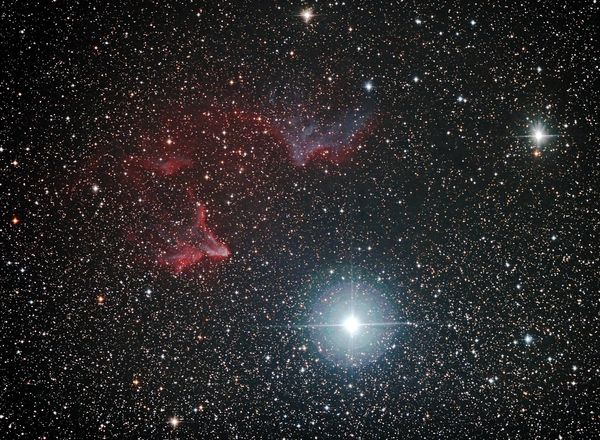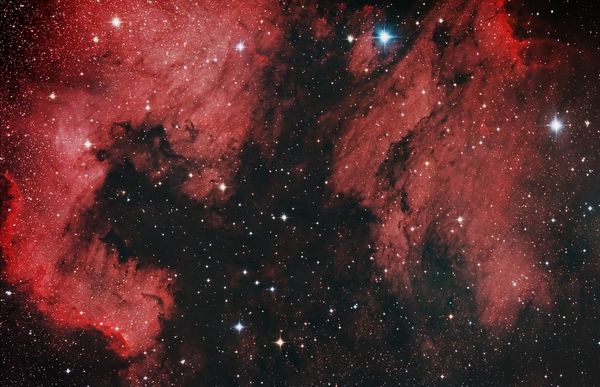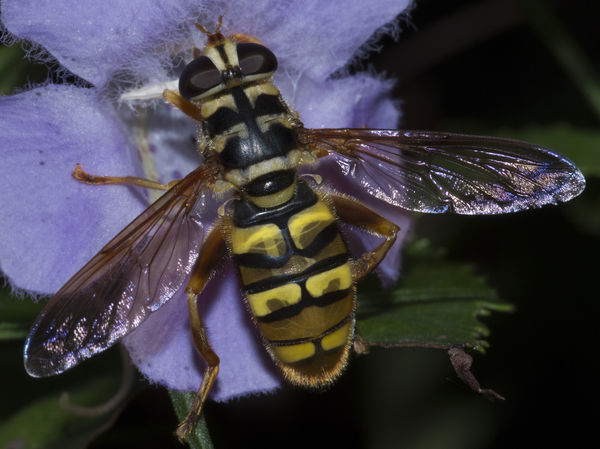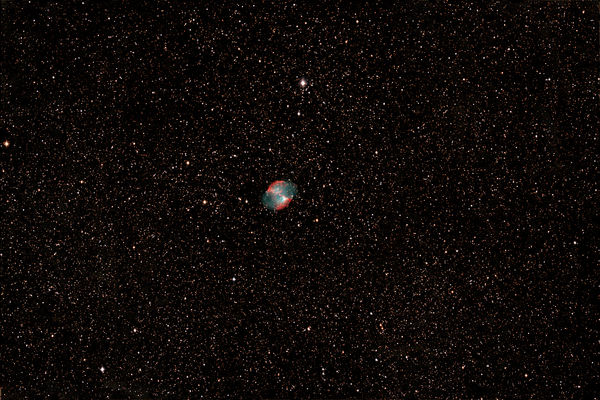Posts for: Algol
Nov 24, 2016 11:09:38 #
This is the bright star Gamma Cassiopeia and the two nebulae above it are known as IC 59 and IC 63. They are a combination of reflection (blue) and emission nebulae (red). 11 inch RASA f/2.2 + Canon 60Da, 72mm Celestron RASA filter, 16 x 120 second subs (total exposure time 8 minutes), ISO 3200.
Nov 24, 2016 10:34:09 #
SonnyE wrote:
Amazing! Beautiful!
Those RASA telescopes are amazing for detail! And a huge FOV!
I am curious though... with that huge light bucket (what was that monster 16"?), why the RASA? (If you don't mind me asking...)
Those RASA telescopes are amazing for detail! And a huge FOV!
I am curious though... with that huge light bucket (what was that monster 16"?), why the RASA? (If you don't mind me asking...)
I have a 14 inch scope that I use for detailed planetary images and smaller objects like galaxies, Planetary Nebulae etc. It has a FOV of about 15' x 20' where as the RASA is used for wide field work and has a FOV of 80' x 120' on a CMOS chip. The 14 is much slower at f/6.3 and the RASA is f/2.2. It seems to have better resolving power than all those APO's that are out there and they usually cost several times as much. Can't beat aperture for resolving power plus fast optics at f/2.2. It has pinpoint images all the way to the edge and exposures are usually less than 2 minutes, depending on the ISO. It amazes me what it can pick up. I will post more images later.
Nov 23, 2016 23:04:59 #
Europa wrote:
You got a ton of detail...I have this same OTA, but I wasn't smart enough to shop the LPR, I went with Celestrons.
Yes, its the same filter, sold by Celestron but made especially for the RASA.
Nov 23, 2016 19:37:00 #
I purchased the 11 inch RASA telescope this past summer and as usual weather has not been cooperating. But we have been able to get some shots as we continue our testing of this extremely fast telescope. Similar to the Hyperstar system, this is a dedicated instrument and so far am very, very impressed with the results.
The image is of NGC 7000 or the North American Nebula. As one ccan see there is an enormous amount of detail in the dark lanes of this nebula. This was taken with a Canon 60Da camera, 72mm RASA light pollution filter, 30 x 1 minute subs at ISO3200.
The image is of NGC 7000 or the North American Nebula. As one ccan see there is an enormous amount of detail in the dark lanes of this nebula. This was taken with a Canon 60Da camera, 72mm RASA light pollution filter, 30 x 1 minute subs at ISO3200.
Sep 22, 2016 18:01:39 #
Female Yellowjacket Hover Fly (Milesia virginiensis) found at Clinton Nature Preserve, Winston, GA
It's been a long while since I posted here, so I thought I might share this. Canon 60Da at ISO 320, Tokina 100mm macro, 1/250-sec at f/16. This is about 85% of the frame.
It's been a long while since I posted here, so I thought I might share this. Canon 60Da at ISO 320, Tokina 100mm macro, 1/250-sec at f/16. This is about 85% of the frame.
Jul 15, 2016 19:18:31 #
nikonshooter wrote:
When you do this again.....use the "spot healing" brush for ONLY the very bright stars.....then use a "gaussian blur" and set to at least 150 - you may have to move the slider all the way to the right - stars will disappear. Works wonders and takes 5 minutes or less.
Thank you, but I already knew of the process that you speak of (see TUTORIAL: Make better astro photos in Light Polluted skies) that I posted on Dec. 2, 2012.
I use that same method most of the time, but there are times when if you do not remove all the stars that a patchwork of blotches may show up or you have some uneven background gradient present. So, I tried this method because of the crowded field and the fact it was very wide field of view and wanted to show it without any cropping. Basically this was a test of the RASA telescope.
Again, thank you for looking at my image.
Jul 15, 2016 14:58:55 #
CraigFair wrote:
Jerry that is a spectacular shot of the Dumbbell Nebula.
Did you do any Post Processing besides stacking???
Craig
Did you do any Post Processing besides stacking???
Craig
Not really, just the standard stacking and bringing up the values so the object could be seen. I did have to create an artificial flat in Photoshop CC which was subtracted from the original. This makes the sky black as the original was a horrendous red-orange due to the glow from Atlanta. I used the spot healing tool to remove each and every star in the image then pasted it to the original and used the difference function. This took several hours to do. Taking appropriate flats would be much, much easier which I will have to learn how to do with this wide field instrument. But at no time were the colors of the nebula changed.
Jul 14, 2016 10:25:21 #
Albuqshutterbug wrote:
For an 11" scope that is a pretty small object. Did you use a focal reducer of any type?
In my 8" SCT this fellow is pretty large.
Now that I am getting a handle on stacking I plan on going after Sonny's namesake next new moon.
You live 30 miles from your big light source, I live in the center of my white zone. :o)
That is a really nice shot on download, you have to be happy with the detail you got.
Awesome.
In my 8" SCT this fellow is pretty large.
Now that I am getting a handle on stacking I plan on going after Sonny's namesake next new moon.
You live 30 miles from your big light source, I live in the center of my white zone. :o)
That is a really nice shot on download, you have to be happy with the detail you got.
Awesome.
Yes it is an 11 inch aperture but it is an f/2.22 system, very fast. The focal length is 620mm and it is for photographic use only, can't look through it as there is no place for an eyepiece. If I need greater detail or higher resolution I switch over to a Meade 14 inch LX200 with either f/10 or putting a focal reducer on it makes the 14 an f/6.3 system. I can also use a Telextender and get ranges from f/16 up to f/22 which is used for moon/planets. The RASA cannot use a focal reducer and the camera attaches directly in front of the corrector plate. It is surprisingly easy to get fine focus especially when used with Backyard EOS program.
Jul 13, 2016 11:13:58 #
SonnyE wrote:
Very cool, Jerry!
I've been wondering how you were doing.
It is good to see you are gathering light.
Does any of the light filters do anything for the light pollution in your area?
I've been wondering how you were doing.
It is good to see you are gathering light.
Does any of the light filters do anything for the light pollution in your area?
This scope takes a 72mm filter and I have an IDAS light pollution filter on order. Problem is when they get that size they become expensive, the IDAS is $330.00 while the Celestron is $499.00!!!!! They are both the same from what I have been told, so the IDAS got the choice. I already have a 2 inch mounted IDAS and it works very well with the 14 inch scope or anything that takes a 2 inch barrel.
Jul 13, 2016 05:44:08 #
I have just purchased a new telescope called the RASA (Rowe-Ackerman Schmidt Astrograph). It is 11 inches in diameter with a focal ratio of f/2.22. This gives me roughly a 1 degree 20 minutes by 2 degree field of view using a Canon 60Da camera. The camera with it's small pixels is suited for this instrument.
Being it is ultra fast, it needs to be used in a very dark site, unfortunately I live just 30 miles from downtown Atlanta (pop 4 million) and so my night sky is heavily polluted. By keeping exposures short ( 10 to 15 seconds) and stacking like crazy I get some decent shots.
Here is an example of M-27, 15 second subs, ISO 6400 total exposure 8 minutes, object was on meridian so I had a lot less light pollution at that point.
Being it is ultra fast, it needs to be used in a very dark site, unfortunately I live just 30 miles from downtown Atlanta (pop 4 million) and so my night sky is heavily polluted. By keeping exposures short ( 10 to 15 seconds) and stacking like crazy I get some decent shots.
Here is an example of M-27, 15 second subs, ISO 6400 total exposure 8 minutes, object was on meridian so I had a lot less light pollution at that point.
Jun 7, 2016 14:38:05 #
Good shooting, nice images on all three.
Nov 28, 2015 06:27:47 #
Algol wrote:
I was successful in obtaining a weak but discernab... (show quote)
I ran a check with Minor Planet Checker and found out that the asteroid is (757) Portlandia at magnitude 15.1, it is a main belt asteroid and has a diameter of 32 km.
Nov 26, 2015 01:34:46 #
CraigFair wrote:
Your expertise is very inspiring Jerry. And very humbling.
Thank you for all your hard work.
Now I'm tring to get DSS to work for me. It always says I don't have enough stars???
And will only stack 1 shot, there has to be something simple I'm doing wrong.
I put that moon link in my "Favorites" it's awesome.
Craig
Thank you for all your hard work.
Now I'm tring to get DSS to work for me. It always says I don't have enough stars???
And will only stack 1 shot, there has to be something simple I'm doing wrong.
I put that moon link in my "Favorites" it's awesome.
Craig
Sometimes if your exposures are too short or if not enough ISO you can come up short on the stars and no matter what you do to increase the number it still doesn't work. I know, I have had it happen to me more than once. Most of the time mine has been my exposure was too short, for example when I'm trying to image a very bright planetary nebula my exposures can be as short as 5 seconds. Then it will tell me I need more stars. No matter how far I slide the bar to get more stars it still won't work half the time. My advice is if you are shooting faint stuff, increase your exposure but not to the point of trailing images, you can also increase your ISO. I have shot ISO as high as 6400. If you can then get a stack, try taking as many images as possible. I sometimes take as many as 500 images each exposed for 15 seconds, then stack as many as 90%. Hope this helps.
Nov 24, 2015 02:12:49 #
skylane5sp wrote:
Would you happen to know the magnitude of the two stars below the comet? Curious as to how deep your lottery light bucket can go.
Amazing image! Thanks!
Amazing image! Thanks!
I do not know the magnitudes of those particular stars, but I did check some areas with photometric data and the 14 inch will get to magnitude 20 in one hour using the Canon 60Da. On older data with the 14 it was reaching magnitude 19.5 in a 90 second exposure using an SBIG ST1001 CCD camera. The difference being is that the CCD had 25 micron pixels while the Canon 60 Da has 4.3 micron pixels. In other words the CCD camera was a big light bucket and could gather more photons per pixel area than the Canon. That's good for going very, very faint but falls short in the resolution category.
Nov 24, 2015 01:52:01 #
pfrancke wrote:
I have to ask... What resolution is needed to see something we left behind on the moon. I am not expecting to see a golf ball, but I figure there must be some boosters or something very large that might be visible.
I like also that it provides latitude and longitude..
I like also that it provides latitude and longitude..
You can actually go onto the main LROC web site, they have an entire section devoted to imagery of man made objects on the moon plus some new craters that were created by spent rocket boosters etc.



